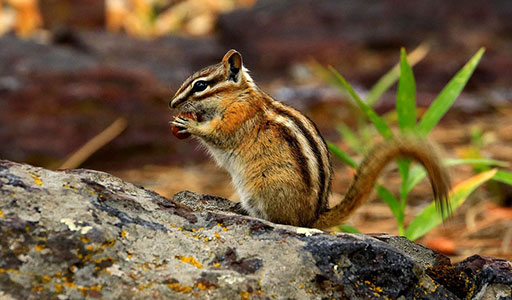Chipmunk Removal
Do you need to get rid of chipmunks? We can help!

Chipmunk Removal Strategies
Chipmunks are known and loved for their chubby cheeks and lightning fast speed. These adorable creatures typically survive for about 2-3 years in the wild and typically never grow heavier than 1 lb. in weight. Chipmunks occupy most of the United States and parts of Canada. Chipmunks primarily live in trees, logs, and shrubs and dig extensive burrow systems under the ground. During the winter, chipmunks live in their underground burrows along with the food they have been stockpiling all year.
Our specialists have the tools and knowledge to solve your chipmunk problem, no matter how big of small. With combined decades of experience, trust that your chipmunk needs are in good hands at Trutech. But don’t wait too long to call- chipmunks can dig burrows up to 3 feet underground, destroying your yard in a matter of days.
Hear what a Chipmunk sounds like
Chipmunk Problem

Signs a Chipmunk is on Your Property
If you have identified chipmunk damage in the form of holes in your lawn, foundational damage, or stockpiles of food, it is time to call the experts at Trutech to perform a chipmunk removal. Our licensed experts have what it takes to remove these tiny creatures from your property humanely and effectively. When it comes to chipmunk removal services, the experts at Trutech are the best of the best. If you need help monitoring the presence of chipmunks on your property, you can also trust Trutech to conduct chipmunk control services in your home, yard, or attic.

Dangers of Chipmunk Infestation
Chipmunks burrow for shelter, which becomes particularly problematic when they nest in residential lawns as it leads to crop destruction and can damage various structures around the yard. Luckily, they travel in small groups and only a few chipmunks are usually found on a single acre of property. Further problems arise when the animals consume pet, bird, or livestock feeds.
Humane Chipmunk Removal & Control Strategies

Entry into property
Although they do so infrequently, chipmunks can enter homes while searching for food and shelter. Given their small size, they are capable of wiggling through any holes a quarter of an inch in diameter or larger. Gardeners and farmers deal with the animals on a regular basis, and they particularly enjoy private properties where nearby watering holes provide ample nourishment.

Trapping & Removal
Trutech employs experts who understand chipmunk habits and can utilize their knowledge to remove the creatures from private properties. Our staff works as a team to assess problems in order to remove chipmunk pests humanely.

Prevention & Exclusion
Property owners can deter chipmunk presence by burying hardware cloth a few inches into the ground — as this stops the animals from digging and damaging structures like sidewalks and patios. Similar methods of prevention involve patching any building holes with caulk. Removing various debris from yards that chipmunks can use for cover, such as woodpiles, lawn care equipment, and organic matter like leaves and brush, also reduces the possibility of attracting the rodents.
Chipmunks on Your Property
Chipmunks are frequently found in residential areas. They prefer to set up their burrows in lawns but may accidentally enter homes by digging underneath building foundations and steps. Chipmunks can also infiltrate houses through cracks and gaps, as well as by using overhanging tree branches to enter attics via holes and vents.

Chipmunk in the House
Most damage caused by chipmunks in the house occurs when they burrow around the foundation. Destruction inflicted on patios, stairs, and retention walls is costly and detrimental to the structural integrity of buildings. The pests also tear up insulation, chew on electrical wiring, and gnaw through cedar shakes. They bite if they feel threatened and are known carriers of fleas. Though chipmunks are small in stature, they cause a sizeable amount of damage once they get inside homes. These animals typically find their way into attics to store nuts, seeds, and fruits. Chipmunks use downspouts to both gain access and hoard food. As such, the presence of chipmunks in the attic leads to backed up gutters and water damage. Chipmunks frequently find their way into private residences through holes in building foundations. Since they burrow underground and take comfort in seclusion, the pests often set up nests inside wall cavities. House residents are able to detect the presence of chipmunks in the walls by listening for squeaking and scratching sounds.
Chipmunk Infestation in Your Yard
Chipmunks thrive on private properties. They frequently inhabit yards and gardens where they cause destruction by feeding and digging into the ground. Property owners are typically able to identify the presence of chipmunks in the yard early on thanks to the appearance of cleanly dug holes a bit larger in diameter than a quarter. These holes are found near wood piles, retaining walls, decks, and patios and do not typically have loose or piled soil near the openings. The pests also dig up newly planted seeds, gnaw on tree bark, and eat flower stems, fruits, and vegetables.
Yard Prevention
Since chipmunks in the yard are so destructive to landscaping, property owners can employ habitat modification methods to reduce the likelihood of attracting the pests. For example, eliminate easy food sources by placing bird feeders away from structures. Certain taste repellents help lessen damage on a short-term basis, but in order to eliminate the pests completely, individuals should contact trained professionals.

Garden Prevention
The best way to keep chipmunks out of gardens is to erect fences that entirely surround them. This entails burying the mesh wire far enough into the ground while also including overhead cover so chipmunks can neither dig under nor climb over. Additionally, property owners can eliminate sources of standing water to make lawns less favorable to the rodents. However, if infestations already exist, contact the pest control experts at Trutech to take care of any chipmunks in the garden.
Chipmunks in The Garden
Gardens offer easily accessible food to chipmunks. Limiting their access to these spaces is challenging because they are both gifted burrowers and climbers. Using shrubs, wood piles, and tall grasses for cover, chipmunks easily sneak their way into gardens, where they stuff their cheeks full of food and leave as quickly as possible. Given their impressive stealth, the presence of chipmunks in gardens may go unnoticed for some time.
When left to forage freely, chipmunks can ruin a garden’s appearance and diminish its output. The pests eat flower bulbs and other plant parts, like roots, which impacts plant health and growth. However, the appearance and fruits of plants isn’t the only thing affected; electrical wiring buried in the ground is susceptible to gnawing when chipmunks in the garden are present.
QUESTION:
Hi, I have a chipmunk problem. I think there are two to three chipmunks tearing up my yard. I have seen them digging into parts of my house as well. A spot behind the stairs to my front door and I have seen one climb up the inside of my garage to parts unseen. Do you guys trap and remove them?
-Wilmington, NC
ANSWER:
Yes, Trutech provides chipmunk removal services. A technician will perform a full inspection of the property to determine the extent of the chipmunk damage. This includes looking for possible entry points to the home and providing a plan for exclusion. We will trap and remove the chipmunks from your property. Trapping typically takes 10-14 days; however, this may vary depending on the extent of the chipmunk intrusion. The technician will also discuss options for a recurring chipmunk population control plan to help prevent future problems.
Frequently Asked Questions
Since it’s so similar to the problems caused by comparable pests like rats and moles, chipmunk damage can be difficult to identify. However, there are some distinguishing characteristics to look for. Moles and chipmunks both burrow, but the former leaves mounds by the entrances to their nests while the latter does not. Instead, chipmunks use their cheek pouches to carry the dirt away from the burrow. They also conceal entrances by placing them near shrub roots or birdfeeders. This keeps them close to their food supply.
Chipmunk damage in the garden is among the most typical. They dig beneath the roots of flowers and eat the bulbs, which slowly kills the plants. Their tunneling can also destroy lawns, driveways, and sidewalks. Additionally, chipmunk damage to foundations is a major, costly problem. Inside homes, these pests gnaw on wooden beams and wiring, which can cause electrical fires.
Common chipmunk diseases include leptospirosis, salmonella, Hantavirus, Rocky Mountain spotted fever, encephalitis, rabies, and the plague. Some of these are spread directly through contact with the pests, their feces, or their urine, while others are transmitted indirectly via ticks and fleas. Although rare, chipmunks will bite humans if threatened, and it’s advisable to seek immediate medical attention afterward. If flu-like symptoms develop, this could be the result of chipmunk disease transmission.
The larger threat chipmunks pose as disease carriers is their ability to host vectors such as fleas and ticks. These insect pests are much more likely to infect humans with chipmunk diseases than the rodents themselves.
Chipmunks are a familiar sight in most residential neighborhoods. One major problem the pests create are the holes they dig as entrances to their burrows, tunnel systems, and food caches. Unlike other burrowing animals, chipmunks dig holes with clean appearances and virtually no dirt piles left from digging.
Chipmunks routinely dig burrows under patios, retention walls, and building foundations. The resulting chipmunk holes and burrows weaken the structural integrity of homes and put house residents in danger. Property owners commonly find numerous chipmunk holes about two inches in diameter throughout their yards when the pests are present.
Though chipmunks are small in stature, they cause a sizeable amount of damage once they get inside homes. The pests typically find their way into attics to store nuts, seeds, and fruits. Chipmunks use downspouts to both gain access and hoard food. As such, the presence of chipmunks in the attic leads to backed up gutters and water damage.
Additionally, they carry various parasites and harbor viruses harmful to humans, including the LaCrosse virus, Colorado Tick Fever, and the plague. Chipmunks in attics can also chew on and damage insulation, support beams, and wiring.
When left to forage freely, chipmunks can ruin a garden’s appearance and diminish its output. The pests eat flower bulbs and other plant parts, like roots, which impacts plant health and growth. However, the appearance and fruits of plants isn’t the only thing affected; electrical wiring buried in the ground is susceptible to gnawing when chipmunks in the garden are present.
Chipmunks frequently find their way into private residences through holes in building foundations. Since they burrow underground and take comfort in seclusion, the pests often set up nests inside wall cavities. House residents are able to detect the presence of chipmunks in the walls by listening for squeaking and scratching sounds.
Additionally, urine and excrement will accumulate, and the rodents occasionally die while trapped in these spaces. This results in a combination of offensive smells that should alert homeowners to a chipmunk in the walls. Similarly, residents sometimes find nests or leftover nutshells along frequently traveled chipmunk paths.
Chipmunks thrive on private properties. They frequently inhabit yards and gardens where they cause destruction by feeding and digging into the ground. Property owners are typically able to identify the presence of chipmunks in the yard early on thanks to the appearance of cleanly dug holes a bit larger in diameter than a quarter. These holes are found near wood piles, retaining walls, decks, and patios and do not typically have loose or piled soil near the openings. The pests also dig up newly planted seeds, gnaw on tree bark, and eat flower stems, fruits, and vegetables.


